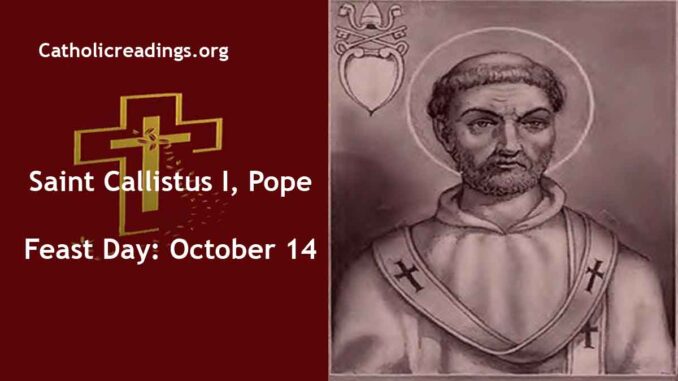Pope St Callistus I, also called Callixtus, was the bishop of Rome from 218 AD until 222 AD.
He was born in the 2nd Century AD and died as a martyr in 222 AD in Rome.
We celebrate his feast day on October 14 every year in the Catholic Church.
St Callistus I, Pope is the patron saint of Cemetery workers, and other popes named Callixtus.
| Saint Callistus, Pope Biography | |
|---|---|
 |
|
| Date of Birth | 2nd Century AD |
| Place of Birth | Rome |
| Profession | Pope and Bishop of Rome |
| Place of Work | Vatican, Rome, Italy |
| Date of Death | October 14 222 AD |
| Place of Death | Rome, Italy |
| St. Callistus, Pope Feast Day | October 14 |
| Canonization | Pre-Congregation |
| Patron Saint of |
|
Pope St Callistus I Life History
The only credible story of the life of Pope Saint Callistus I is given by Saint Hippolytus. Saint Hippolytus hated Pope Saint Callistus to the point that he became an antipope to Pope Callistus.
According to Hippolytus, early in his life, Pope Callixtus I was a slave from Rome who worked for his master, Carpophorus.
He was in charge of funds that had been collected from other Christians for some sort of banking business.
At one time, he lost the money and fled from his master by ship. When Carpophorus caught up with him, he jumped overboard but was rescued.
He was caught and brought back and after trial, he was given a harsh sentence but was released after a pardon from the Christians who had contributed with a promise to recover the money from his debtors.
After release, he went to the synagogue and started collecting debts. He was caught there fighting and causing a public disturbance while forcefully recovering the debts and was sentenced to hard work in the mines of Sardinia.
He was later rescued, together with some other Christians by a eunuch presbyter named Hyacinthus after Pope Victor I and the emperor made negotiations. This rescue was catalyzed by the emperor’s mistress who was sympathetic to Christians.
His health was so frail that he was sent to Antium to convalesce. In 199 AD, he was ordained as a deacon by the new Pope Zephyrinus and made in-charge of the Christian cemetery on the Appian Way. This piece of land is still called the Catacombs of St. Callixtus up to date.
After Pope Zephyrinus died, St Callistus became pope. He started admitting to the Church people who had converted from other sects and schisms without doing public penance. He also introduced absolution of all sins including murder, fornication, and adultery.
According to Hippolytus, this practice of absolution allegedly encouraged men to have extra-marital affairs with their slaves and brought laxity in communion with the Church and morals.
Hippolytus used this criticism to oppose the pope and was elected by his followers as a rival pope to Callistus. Hippolytus became the first antipope.
According to Pope Callistus, every sin can be forgiven if the penitent confesses with a sincere and contrite heart but according to Hippolytus, some sins are too grave to be absolved through confession.
The stance of Pope Callistus carried and still carries the day because he asserted and proclaimed the power and love of God’s Divine Mercy to all repentant sinners.
Hippolytus went ahead to oppose the subsequent popes, Pope Saint Urban I and Pope Saint Pontian.
Later on, in 235-236, he reconciled with Pope Saint Pontian as well as the Church when they were together in exile in the mines of Sardinia during the persecution of Christians by the Roman emperor Maximinus.
Pope Saint Callistus’s Death
Saint Callistus I died as a martyr around 222 AD after a riot and uprising against Christians. His body was buried in the cemetery of Calepodius on the Aurelian Way.
In the ninth century, his remains were transferred to the Basilica of Santa Maria in Trastevere in Rome.
Feast Day
We celebrate his feast day on October 14 every year in the Catholic Church.
Pope St Callistus is the Patron Saint of
- Cemetery workers
- Other popes named Callixtus
Other Catholic Saints whose Feast Days are in October
Related Links
Powered By SEO Experts
Follow @ReadingCatholic
